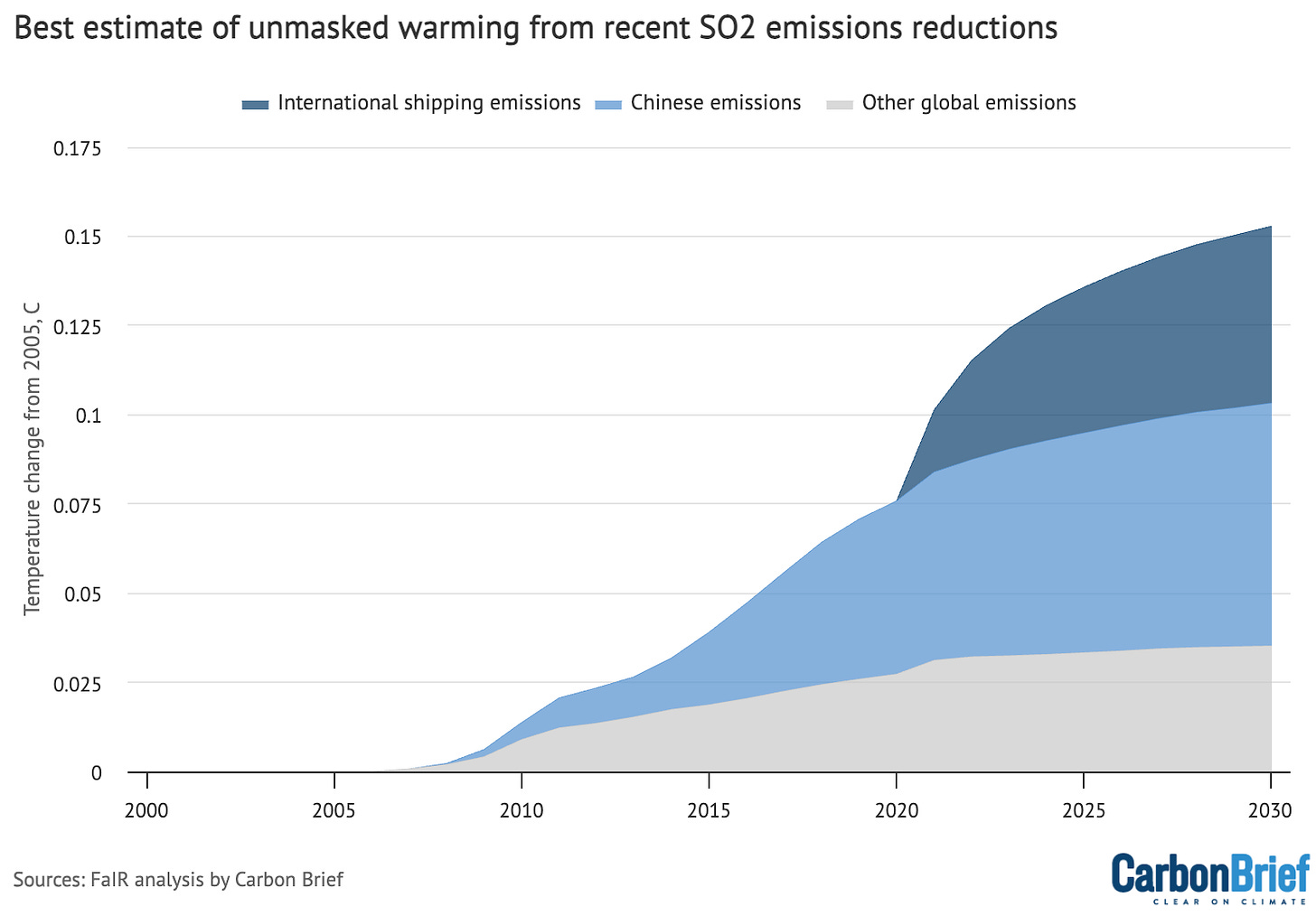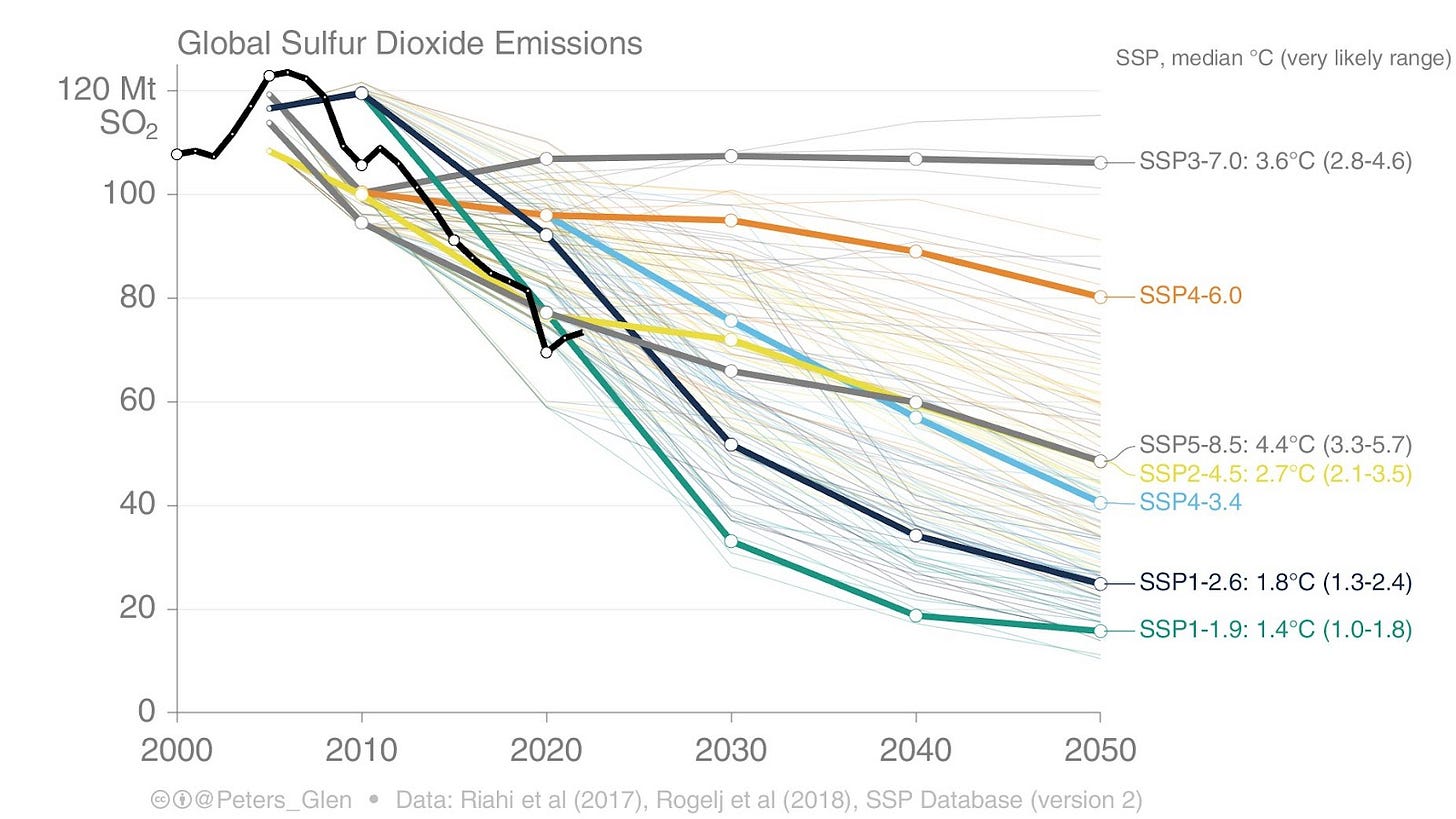The role of aerosol declines in recent warming
SO2 declines have contributed ~25% of recent warming and driven recent acceleration.
Over at Carbon Brief I have a new detailed explainer on aerosols. They have a major (but poorly constrained) cooling effect on the climate, masking about 0.5C warming from CO2 and other greenhouse gases that would otherwise have occurred.
However, we are rapidly reducing both aerosol emissions and their resulting climate cooling effect. Global emissions of SO2, the most important aerosol, have fallen by 40% since the mid‑2000s. China has cut its SO2 emissions more than 70% over the same period.
This is a good thing; SO2 is a major precursor to PM2.5, which is responsible for millions of deaths from outdoor air pollution worldwide. But reductions to clean the air are quickly unmasking more warming from our past greenhouse gas emissions.
While the Carbon Brief piece goes into quite a bit of detail about how aerosols influence the climate and how emissions have changed over time, I thought readers here would be particularly interested in the novel part of the piece where I estimate the global temperature impact of these recent reductions.
Effects of low-sulphur shipping fuel
The climate effects of the IMO’s 2020 phase-out of most of the sulphur content in shipping fuel has received a lot of attention over the past two years (see Carbon Brief’s earlier coverage of the topic).
This has been explored by researchers as a potential explanation for the record levels of warming the world has experienced in recent years.
Determining the climate effects of low-sulphur shipping fuel is less straightforward than simply assessing the reduction in global SO2 emissions.
The impact of additional SO2 emissions on cloud formation diminishes as emissions increase, meaning that reductions in SO2 over areas with low background sulphate concentrations, such as the ocean, could result in a proportionately larger warming effect than in highly polluted areas, such as south Asia.
This is somewhat countered by the concentration of shipping in specific “lanes” and by natural emissions of dimethyl sulphide produced by algae that are not present on land. Assessing the radiative forcing impact of the IMO’s 2020 regulations in greater detail requires the use of sophisticated climate models that can simulate these regional effects.
Carbon Brief conducted a survey of the literature on the climate impacts of the 2020 low-sulphur marine fuel regulations. Of eight studies published in peer-reviewed journals over the past two years, shown in the chart below, most determined a radiative forcing change of around 0.11 to 0.14 watts per meter squared (w/m2).
One estimate from Skeie et al. (2024) was a bit lower at around 0.08 w/m2 and another from Hansen et al. (2025) was substantially higher than all the others at 0.5 w/m2.

To account for these differing studies, Carbon Brief used the FaIR climate model emulator to simulate the effects of the radiative forcing estimated in each study on global average surface temperatures between 2020 and 2030. This includes 841 different simulations for each study to account for uncertainties in the climate response to aerosol forcing. (See: Methodology in the Carbon Brief article for further details.)
These estimates were then all combined to provide a central estimate (50th percentile) that gives each study equal weight, as well as a 5th to 95th percentile range across all the simulations for each different forcing estimate, as shown in the figure below.

Overall, this approach provides a best estimate of 0.04C (0.02C to 0.16C) additional warming from the IMO’s 2020 regulations as of 2025, increasing to 0.05C (0.03C to 0.2C) by 2030.
These large uncertainty ranges are due to the inclusion of the Hansen et al. (2025) estimate, which represents something of an outlier relative to other published studies. Note that the warming of the climate system associated with the IMO 2020 regulations increases over time in the plot due to the ocean’s slow rate of warming buffering the climate response to forcing changes.
Declines in Chinese SO2 are unmasking warming
China’s reduction of SO2 emissions by more than 70% since 2007 represents a remarkable public health success story. It is estimated to have prevented hundreds of thousands of premature deaths from air pollution annually.
These rapid emissions cuts by China represent more than half the reduction in global SO2 emissions since 2007. They have been a major contributor to global temperature increases over the past two decades.
To determine the impact of Chinese SO2 reductions on global average surface temperatures, Carbon Brief used Chinese SO2 emissions data from the Community Emissions Data System (CEDS) combined with the FaIR climate model emulator.
The figure below shows the central estimate and 5th to 95th percentile across 841 different FaIR model simulations to account for uncertainties in the climate response to SO2 emissions.

The figure above shows that Chinese SO2 declines were likely responsible for a global temperature increase of around 0.06C (0.02C to 0.13C) between 2007 and 2025, increasing to 0.07C (0.02C to 0.14C) by 2030.
Much of this increase occurred between 2007 and 2020, with a more modest contribution of Chinese aerosol changes to warming in recent years.
These results are nearly identical to those found in a study currently undergoing peer review by Dr Bjørn Samset and colleagues at CICERO, which finds a best estimate of 0.07C (0.02C to 0.12C) using a large set of simulations from eight different Earth system models.
This suggests that Chinese SO2 reductions are responsible for approximately 12% of the around 0.5C warming the world experienced between 2007 and 2024.
What aerosol cuts mean for current and future warming
It is clear that rapid reductions in global SO2 emissions have had a major impact on the global climate.
The combination of declines in emissions since 2007 in China and the rest of the world, along with declines in SO2 from shipping after 2020, have collectively unmasked a substantial amount of warming driven by GHGs.
While the reduction in SO2 emissions in other countries has been proportionately smaller than that seen in China, collectively it adds up to 0.03C (0.01C to 0.07C) of warming in 2025.
The figure below provides a best-estimate of all three factors: declines in SO2 emissions in shipping, China and the rest of the world.

Taken together, these declines in SO2 emissions may represent around 0.14C additional warming today, or more than a quarter of the approximately 0.5C warming the world has experienced between 2007 and 2024.
However, the uncertainty in the climate response to changes in aerosol emissions remains large, particularly for changes in shipping emissions, so it is hard to rule out either a much smaller or much larger effect.
These results are in line with other recent analyses showing that changes in aerosol emissions are contributing to an increase in the rate of human-caused global warming in recent years.
The figure below uses a similar FaIR-based climate modeling approach to assess how different factors contributing to human-caused warming have changed over time.

This shows that the rate of human-caused warming remained relatively flat at around 0.18C per decade from 1980 to 2005, before accelerating to around 0.27C over the past decade.
The primary driver of this recent acceleration in warming has been declining aerosol emissions.
Aerosols have flipped from reducing the rate of decadal warming (as emissions increased) to increasing the rate of warming (as emissions decreased) after 2005 by unmasking warming from CO2 and other GHGs.
The rate of warming from CO2 has increased over time as emissions have increased, though it has plateaued over the past decade as increases in global emissions have slowed.
However, the rate of warming from all GHG emissions – CO2, methane and others – has been relatively consistent since 1970. This is primarily due to the declining contribution of other GHGs to additional warming, likely associated with the phaseout of halocarbons after the Montreal Protocol.
Future declines in aerosols are expected in most of the Shared Socioeconomic Pathways (SSPs) used to simulate potential levels of future warming for the IPCC AR6 report, as shown in the figure below.
Modelled future SO2 emissions are generally dependent on broader mitigation trends – worlds with less fossil-fuel use result in less sulphur emissions – but are also highly variable across different models.
Observed SO2 emissions (black line) are broadly at the same level as (though slightly below) the SSP2-4.5 scenario (yellow line), which is the pathway that most closely matches current climate policies.
Observed SO2 emissions are also similar to those in the very-high emissions SSP5-8.5 scenario (lower grey line), while being higher than emissions in the most ambitious mitigation scenario (SSP1-1.9, green line) and below those in the SSP1-2.6 scenario (navy blue line).

Given differences across modeling groups, it is hard to infer too much about which SSP scenario is most in line with real-world SO2 emissions. However, it is worth noting that the current SSPs do not include a scenario where SO2 emissions continue to rapidly decline while emissions of CO2 and other GHGs increase.
Interestingly, the best-estimate cooling effect from sulphur dioxide is more or less counterbalanced by the warming effect of methane emissions today. As a result, scenarios where all GHG emissions are brought to zero do not result in sustained additional warming due to unmasking from declining aerosols.
However, if CO2 emissions alone were reduced to zero, while non-CO2 emissions were held constant, cutting global aerosol emissions to zero would result in between 0.2C and 1.2C of additional warming.
This means that aerosol emissions represent something of a wildcard for future warming over the 21st century. Continued rapid reductions in SO2 emissions will contribute to an acceleration in the rate of global warming in the coming years.


This is quite concerning because aerosols are NOT globaland this issue can not be dealt with using global only models. Indeed Morgenstern finds that models overestimate the effects of aerosols.
Morgenstern, O., 2024: Using historical temperature to constrain the climate sensitivity, the
transient climate response, and aerosol-induced cooling. Atmos. Chem. Phys., 24, 8105–8123,
https://doi.org/10.5194/acp-24-8105-2024.
In our own work, we find that the biggest heating is in the southern hemisphere where there are no aerosols.
Trenberth. K.E., L. Cheng, Y. Pan, J. Fasullo and M. Mayer, 2025: Distinctive pattern of global warming in ocean heat content J. Climate, 38, 2155-2168 https://doi.org/10.1175/JCLI-D-24-0609.1
Here heating is integrated through the ocean, not just surface temperatures.
Certainly aerosols have magnified warming in the northern hemisphere, but there is a LOT more to this.
Kevin
Nice work. I’ve wondered about the net effect of aerosol reduction and this work gives a good accounting of the range.